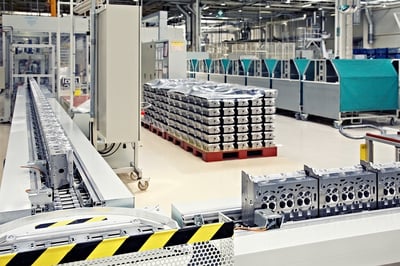5 Reasons to Install a Duress Alarm System on Your Manufacturing Floor
 Worker safety is of paramount importance within the manufacturing industry. Good safety records keep OSHA and other government regulators from knocking, and help to reduce the growing costs of workers' compensation insurance. But on a personal level, no owner, manager, or supervisor wants their workers injured. These workers aren't just a financial investment, they are the heart and soul of the company. Here are several reasons why your manufacturing facility needs to add a duress alarm system to your safety plan as soon as possible.
Worker safety is of paramount importance within the manufacturing industry. Good safety records keep OSHA and other government regulators from knocking, and help to reduce the growing costs of workers' compensation insurance. But on a personal level, no owner, manager, or supervisor wants their workers injured. These workers aren't just a financial investment, they are the heart and soul of the company. Here are several reasons why your manufacturing facility needs to add a duress alarm system to your safety plan as soon as possible.
1. Manufacturing Facilities are Notoriously Noisy
The noise on most manufacturing floors can drown out calls for help, and the configuration of equipment often makes it difficult to see other workers during the shift. A duress alarm can signal for help, even when no one would be within clear sight or sound distance for many hours. This eliminates the need for a supervisor or worker to halt productivity and make regular rounds to check on everyone, or implement an expensive and unproductive "buddy system.".
2. Manufacturing Facilities are Filled With Dangerous Things
Heavy equipment, dangerous chemicals, and other items found on the manufacturing floor pose obvious and constant hazards to all workers and visitors. Equipment malfunctions, human errors, and other issues can cause accidents to occur quickly, without warning. A duress alarm system can notify help immediately if an accident happens or a worker gets into trouble, even if no one is around to see the problem or hear their cries for help.
3. Duress Alarms Can Notify Help Even When the Worker is Unable to Respond
Some problems render the worker incapable of calling for help. Not all emergencies that happen on the manufacturing floor have to do with the equipment or manufacturing processes either -- workers are susceptible to heart attacks, strokes, slip and fall accidents, allergic reactions, and all sorts of emergencies that can render them unable to summon help. A duress alarm that comes with a Man Down feature can summon help if the worker is down but can't call for help. Another feature, called the No Response feature, can be used to periodically ping workers, issuing an alarm if a worker fails to respond in a timely manner.
4. Duress Alarms Give Rescue Workers the Location of the Duress Situation So No Time is Wasted Searching
Duress alarms don't just signal that an emergency occurred -- these systems also include information about where the problem is, and often who is involved. This eliminates wasted time while rescuers search for the victim. In many cases, seconds can determine whether the worker is able to recover fully from an accident or injury.
5. No-Response Features Can Help Supervisors Keep Track of All Workers, Anywhere in the Facility
OSHA does not specify how often lone workers need to be checked on, but with a duress alarm, you can ping them regularly to make sure everyone is okay.
OSHA specifies that lone workers must be checked on regularly, but there are no official guidelines about how often is often enough. No response features allow each lone worker to be pinged regularly. If they do not respond, an alert is issued so that someone can go check on them. This helps keep your company in compliance with OSHA regulations, and also helps you protect your valuable workers.
Better understand why your workers need to be protected with our FREE eBook "Understanding Lone Worker Policies and Standards for 2016."





